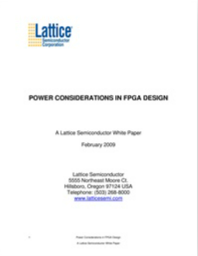POWER CONSIDERATIONS IN FPGA DESIGN
Power has always been a design consideration. Traditionally, though, a lower priority has been assigned to power than to most other variables (speed/performance, cost, time-to-market, risk, etc.). In today's marketplace, however, power has become a very important component in the designer's decision making process. There is good reason for this. Power translates to significant system cost.
Download this whitepaper to learn more.
Read More
By submitting this form you agree to Lattice Semiconductor Corporation contacting you with marketing-related emails or by telephone. You may unsubscribe at any time. Lattice Semiconductor Corporation web sites and communications are subject to their Privacy Notice.
By requesting this resource you agree to our terms of use. All data is protected by our Privacy Notice. If you have any further questions please email dataprotection@techpublishhub.com
Related Categories: Analog, Components, cooling, Evaluation boards, Power, Switches

More resources from Lattice Semiconductor Corporation
DESIGNING FOR LOW POWER
Power consumption is becoming an increasingly important variable when it comes to calculating OPEX and carbon footprint for telecom infrastructure ...
HDMI® Enhanced Audio Return Channel (eARC) Future Proofs Home Theater Connectivity with Uncompromised Audio Quality
HDMI Version 2.1 is the specification's most substantial upgrade. Video delivery speed increases 300%, and a compression feature can increase this ...
Pre-tested System-on-Chip Design Accelerates PLD Development
Many moderate size Programmable Logic Device (PLD) designs, especially those in control plane applications, consist of a number of interfaces inter...
